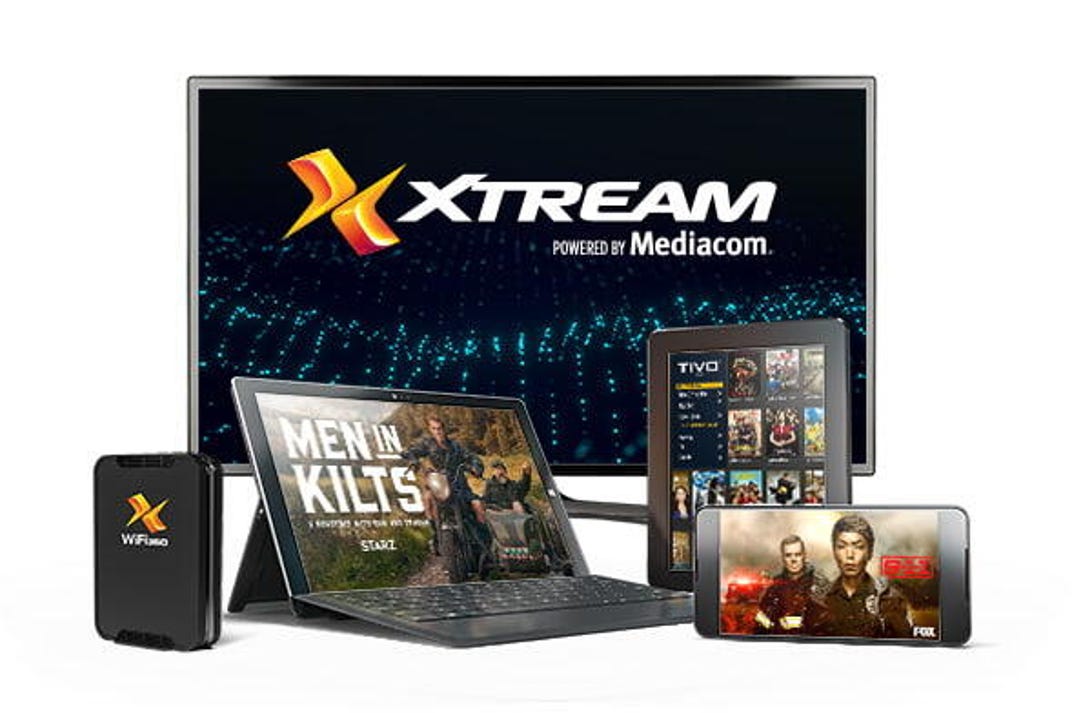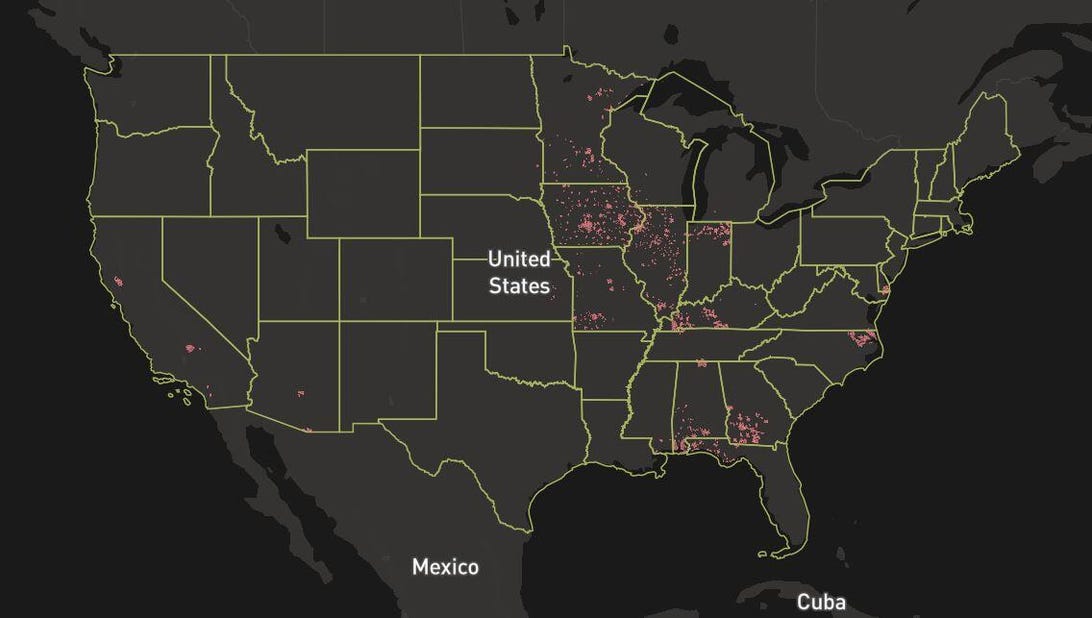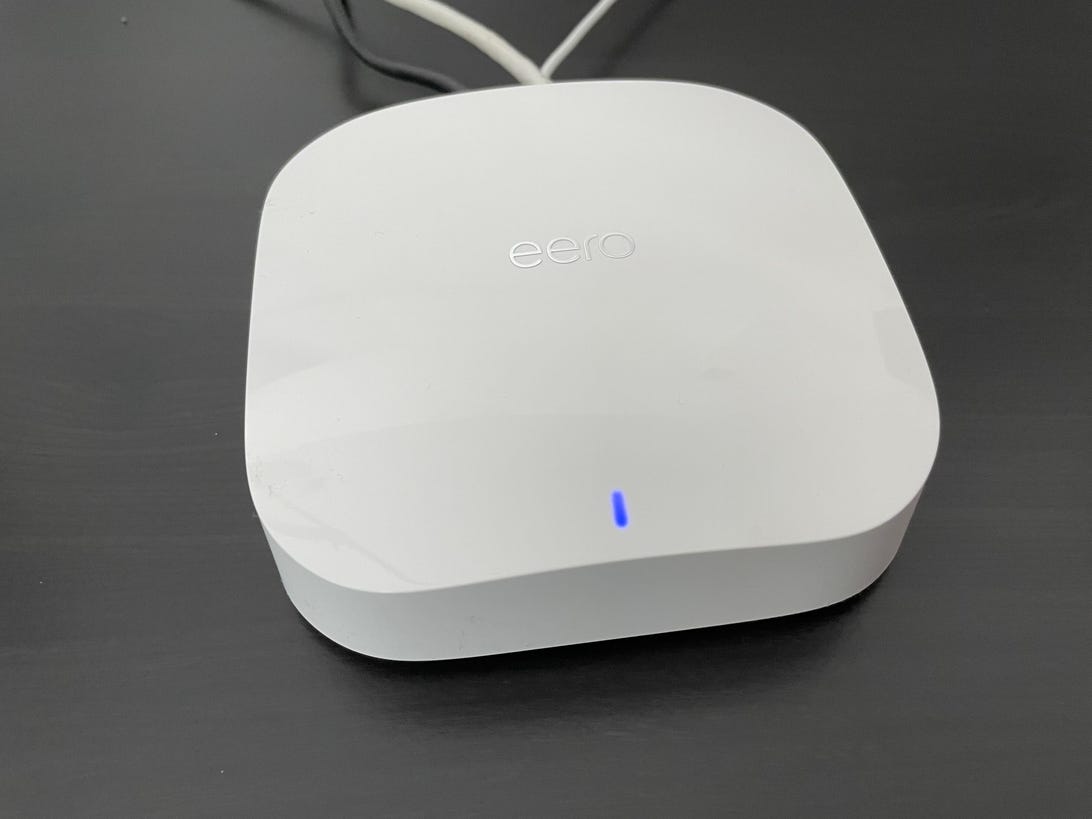
Mediacom
I really can’t think of a brand name that manages both to raise and lower expectations quite like “Xtream.” I mean, I get it — you’re a midsize cable provider with a limited market share, and you’re looking up at the likes of Comcast Xfinity. You want to stand out, but you also want to fit in. So, you write a big “X” on a white board somewhere, you call a meeting, you brainstorm a bit, and at the end of the day, there’s a big circle around “Xtream” and everyone’s patting each other on the back. These things happen.
Dumb name or not, the branding of Mediacom’s home internet service sets the table for streaming at high speed — and one could argue that Xtream largely delivers, with gigabit downloads available to more than 95% of serviceable addresses in the company’s coverage map, as per the FCC, as well as the option of bundling in TiVo-powered cable TV. On top of that, Mediacom Xtream cable internet plans offer upload speeds of up to 50Mbps — that’s nothing compared to what fiber is capable of, true, but it’s faster than the upload speeds of any cable internet plan from Comcast, Spectrum or Cox, all of which top out at 35Mbps (Xfinity, you just got Xtreamed).
Like
- Gigabit download speeds available to over 95% of customers
- Great router hardware available to rent at a fair price
Don’t Like
- Prices go up two years in a row with some plans
- Data caps are too tight with the cheapest plans, and there’s no limit to the number of overage charges you can rack up
- Poor value relative to other cable internet providers
That said, Xtream isn’t perfect. For starters, the price of the two fastest plans goes up after the first year, and then it goes up again at 24 months. Additionally, while its scores have been ticking up for the past two years, Mediacom is still ranked beneath the industry average for ISP customer satisfaction by organizations like J.D. Power and the American Customer Satisfaction Index. That might have something to do with Mediacom’s monthly data caps, which get particularly tight if you’re subscribed to the lowest speed tier, or the fact that you’ll tend to find better value from Mediacom’s cable internet competitors, including other midsize providers like Optimum and Wide Open West.
If you can look past all of that, Mediacom’s cable plans make sense as a strong alternative to inferior DSL, satellite and fixed wireless connections — and give Mediacom some credit for offering cable internet with gigabit download speeds in a variety of rural and suburban markets where faster internet options usually aren’t available at all. Still, Xtreme internet falls well short of the truly extreme performance of a good fiber network, and the questionable value relative to other cable providers makes it a difficult ISP to get excited about, if such a thing is even possible.

FCC/Mapbox
Where does Mediacom offer Xtream internet service?
The nation’s fifth-largest cable provider, Mediacom’s home internet services are available to 7.7 million Americans across a smattering of regions in the Midwest, the Gulf Coast, the Eastern Seaboard and in California and Arizona. Major metro areas of note in that coverage map include Columbus, Georgia; Des Moines, Iowa; Duluth, Minnesota; Huntsville, Alabama; Ocean City, Maryland; Pensacola, Florida and Springfield, Missouri. You’ll also find Mediacom’s Xtream internet services across a wide range of rural pockets near places like Apache Junction, Arizona; Clearlake, California; Decatur, Indiana; Elizabeth City, North Carolina and Murray, Kentucky.
What kind of internet service does Mediacom offer?
“Our approach is simple: Deliver faster internet speeds, build larger fiber networks and offer superior products and services at an affordable price,” writes Mediacom founder, chairman and CEO Rocco B. Commisso on the Xtream website.
That bit about fiber peaked my interest. According to data shared with the FCC at the end of 2019, Mediacom’s internet infrastructure consisted entirely of cable connections, with fiber hookups making up exactly 0% of the footprint.
According to the FCC, Mediacom’s internet infrastructure consists entirely of cable hookups.
FCC
“Across all areas, network engineers and their tech teams have been adding nodes, building out more fiber and expanding capacity,” a Mediacom spokesperson explained when I asked about the company’s plans for fiber. That’s more about buttressing the existing cable connections than establishing new, dedicated fiber connections, but Mediacom adds that true fiber-to-the-home hookups are in the works, “for some projects that build to new communities.”
Meanwhile, Mediacom is currently in court battling it out with Google to try and stop an upcoming fiber expansion in West Des Moines. Mediacom’s argument is that the city is “distorting the communications competition” by granting Google an exclusive subsidy and other benefits as the company seeks to expand its Google Fiber internet service to a 12th city. It’ll be an interesting case to watch — Mediacom also claims that West Des Moines negotiated its Google Fiber deal after Google’s chief lobbyist for Iowa was elected to the city council.
At any rate, as a provider of cable internet, Mediacom can offer customers gigabit download speeds as high as 1,000Mbps (1Gbps), which is much faster than you can expect from providers of DSL, satellite or fixed wireless internet. The downside to cable is that, unlike fiber, your upload speeds will always be much, much slower than that, which can be noticeable if you’re trying to upload large files to the web or join a high-res video call. This is true of all cable providers, most of which won’t offer upload speeds any faster than 35Mbps. Mediacom at least cranks things up to 50Mbps with its gigabit plan. And while we’re on the topic of plans…
Mediacom Xtream home internet plans
| Max speeds | Promo rate (first 12 months) | Standard rate (after 12 months) | Equipment fee | Data cap | |
| Access Internet 60 | 60Mbps download, 5Mbps upload | $20 | $30 | $12 modem rental (skippable) | 200GB |
| Internet 100 | 100Mbps download, 10Mbps upload | $50 | $80 | $12 modem rental (skippable) | 1,000GB (1TB) |
| Internet 300 | 300Mbps download, 30Mbps upload | $60 | $90 ($100 after 24 months) | $12 modem rental (skippable) | 2,000GB (2TB) |
| Internet 1 Gig | 1,000Mbps download, 50Mbps upload | $80 | $110 ($140 after 24 months) | $12 modem rental (skippable) | 6,000GB (6TB) |
Prices that go up — and up
With just four plans to pick from, Mediacom’s Xtream internet offerings are simple and relatively straightforward. Whichever one you go with, expect the price to jump after year 1, which is mostly the norm among internet providers. If you select either of the two fastest plans — Internet 300 or Internet 1 Gig — you can expect your bill to go up after 12 months and again after 24 months.
The double price increase means that the gigabit plan goes from a cost-per-Mbps of 8 cents during your first year up to 11 cents after 12 months, and then up to 14 cents from month 24 onward. Essentially, that’s a good deal in year 1, a so-so deal in year 2, and a bad deal after that.
It’s also roughly on par with Mediacom’s biggest rivals in the cable category. It varies by region, but Comcast Xfinity’s gigabit plan goes from about 9 cents per Mbps during year one up to 10 cents per Mbps in year two. Meanwhile, gigabit service from Cox and Spectrum rings in at a respective 13 and 14 cents per Mbps after the one-year promo rates expire. However, the other midsize cable providers of note, Optimum and Wide Open West, each offer gigabit plans at better prices than Mediacom does, with WOW’s gigabit plan coming in at $75 per month after the promo rate expires. That’s less than 8 cents per Mbps, and an even better value than Mediacom offers while its promo rate is active.
Mediacom’s plans in the middle offer questionable value, as well. Take the Internet 100 plan, which offers download speeds of up to 100Mbps and uploads up to 10Mbps for $50 per month during your first year and $80 per month after that. Depending on where you live, a 100Mbps cable plan from Comcast might cost you as little as $55 or even $30 per month after the promo rate expires. Meanwhile, the slowest cable internet plan from Spectrum offers speeds of up to 200Mbps — twice as fast as that Mediacom plan — for $75 per month after the promo period ends. Cox offers a 150Mbps plan that’s $84 per month after the first year (50% faster than Mediacom for 5% more). Meanwhile, Optimum and WOW each offer 100Mbps plans that are at least half as much as what Mediacom charges — even WOW’s gigabit plan is less expensive than Mediacom’s 100Mbps plan.
As for Mediacom’s entry-level, 60Mbps plan, it costs just $20 per month during the first year and $30 per month afterwards. That’s a perfectly reasonable deal if 60Mbps is all you need, but most homes, particularly homes with multiple internet users, will want at least a little more oomph. I’ll also note that the 60Mbps plan comes with Mediacom’s most restrictive data cap — more on that in just a second.
Admittedly, you can’t really comparison shop between cable providers — you just have to go with the provider that offers service in your area. Still, after looking at the numbers, it’s clear that Mediacom’s prices run on the high side. If it were my provider, then I’d be prepared to point out the gulfs in pricing with its competitors when I inevitably called to try and negotiate a better deal.
Details on those data caps
Mediacom enforces data caps with each of its Xtream internet plans. The specific, monthly data allotment varies from plan to plan, and if you exceed it in a given month, you’ll start incurring penalties.
With the gigabit plan, you get a whopping 6,000GB (6 terabytes) of data each month, which is just an enormous amount of data. (For reference, the average home’s internet usage spiked to a peak of about 400GB per month in 2020, while everyone was at home using the internet way more than usual.) The Internet 300 plan brings the cap down to 2,000GB (2TB), but that’s still quite generous, and more than enough for most households.
The 100Mbps plan comes with 1,000GB of data each month (1TB). That’s more in line with most other data caps, if not slightly lower. For instance, Comcast enforces a data cap of 1.2TB across all plans, while Cox caps you at 1.28TB. Even so, 1TB is reasonable, as data caps go.
Less reasonable is the entry-level 60Mbps plan, which comes with a data cap of just 200GB. That’s about half of what the average home uses in a month these days, and far more restrictive than you’ll get with any other cable plan that we’ve written about to date. Even the data caps with Rise Broadband’s fixed wireless internet service are more generous. In fact, the only data caps we’ve seen that are worse than what you get with Mediacom’s 60Mbps plan are the ones that come with satellite internet plans from Hughesnet or Viasat.
As for penalties, Mediacom will charge you $10 for every 50GB block of data used in excess of the cap — and unlike most providers that enforce data caps, I see nothing in the fine print that limits the total amount in penalties you can rack up in a given month.

If you need a router, Mediacom will rent you a two-piece Eero Pro 6 setup for $10 per month. That’s a good deal for a very decent mesh router.
Ry Crist/CNET
Equipment fees and other charges
Mediacom doesn’t tie you down to a contract with any of its Xtream home internet plans, but you will need to pay a $10 activation charge when you first start service. Xtream home internet also requires a DOCSIS 3.0 modem. Mediacom will happily lease you one for $12 per month, but you can skip that fee if you already have one of your own.
If you like, Mediacom will rent you a router, too — specifically, the Eero Pro 6 mesh router, a recent model that supports Wi-Fi 6 (and which performed quite well when I tested it out at home last year). Ten dollars per month gets you a two-piece setup — one device to serve as the router and a second that functions as a mesh extender. If you live in a large home and need additional Eero extenders, you can add them for an additional $6 per month each.
That’s not a bad deal if you don’t already own a router you like. The Eero Pro 6 two-pack would cost $400 if you bought it outright, so you could rent it from Mediacom for a few years and still come out ahead.
Mediacom received a below-average score from the American Customer Satisfaction Index in each of the past three years.
American Customer Satisfaction Index
Customer satisfaction could be stronger
Organizations that track customer satisfaction metrics tend to agree that Mediacom is a bit below average in the internet provider category. That’s been the case for multiple years running with the American Customer Satisfaction Index, where Mediacom currently sits at a score of 60 out of 100. That’s a point better than the year before, and five points better than two years ago, but even with the positive momentum, it’s still five points behind the industry average of 65.
Meanwhile, J.D. Power tracks ISP customer satisfaction across four regions in the US. Mediacom was only rated in the West region, where it received a score of 670 out of 1,000. That’s the region’s second-worst score (only perennial low-scorer Frontier fared worse), and below the region’s industry-wide average of 718. Mediacom’s cable TV service didn’t fare any better. In a separate J.D. Power ranking, it finished dead last in the West, with a customer satisfaction score of 646 out of 1,000.
As for low-income subscribers, Mediacom deserves credit for participating in the government’s Emergency Broadband Benefit program, and for offering subscribers who qualify a plan with baseline broadband speeds (25Mbps download, 3Mbps upload) for just $10 per month, with no price increases at all. To qualify, your home will need to include at least one K-12 student with eligibility for the National School Lunch Program.
The verdict
Mediacom’s Xtream home internet is a valid option for a fast connection at home, but the plans don’t offer value that’s as good as what you’ll get from fiber, or from other cable providers across the country, and you’ll have to put up with a data cap, too. Things get slightly more appealing if you need to rent a router, as Mediacom offers excellent hardware for the price, but outside of that, there’s just not much to get excited about here.
Still, Mediacom offers gigabit speeds in a lot of markets that don’t have an abundance of other options — and its cable plans are definitely worth it over the likes of DSL, satellite or fixed wireless. You have to take the good with the bad with any ISP, and Mediacom is no different. It’s just a shame that the plans don’t come at a better value.





More Stories
Satellite Internet Broadband Speeds As a Modern Necessity
Internet Banking Security Now More Enhanced
When Internet Marketing Promotions Can Suffer If You Use Audio, Video Or Long Sales Letters